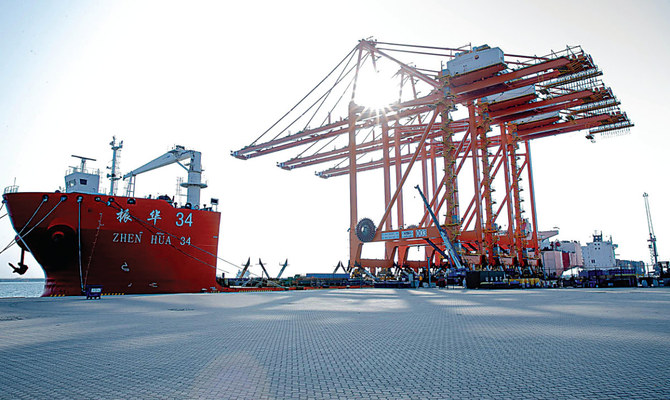
Kingdom’s merchandise exports reached a seven-month high in October totaling SR104.31 billion
RIYADH: Saudi Arabia’s merchandise exports reached a seven-month high in October totaling SR104.31 billion ($27.8 billion), data released by the General Authority of Statistics showed.
Representing a marginal increase of 0.014 percent compared to September, the change is attributed to a rise in non-oil shipments from the Kingdom. Data also shows an uptick in non-oil exports to India and Singapore.
This sector, excluding re-exports, saw a 9 percent increase during the period, amounting to SR18.25 billion and making up 17.5 percent of the total external trade from Saudi Arabia.
Re-exports, which refer to goods that are transshipped through Saudi Arabia to their final destinations, declined by 14 percent during this period, reaching SR3.78 billion.
Oil shipments, constituting a 78.9 percent share of the Kingdom’s total exports in October, decreased by 1 percent, reaching SR82.28 billion. This decline aligns with Saudi Arabia’s ongoing voluntary oil output cuts of 1 million barrels per day as part of the policy adopted by the Organization of the Petroleum Exporting Countries and its allies, known as OPEC+, aimed at stabilizing the global crude markets.
The overall trade volume in October reached SR178.21 billion, marking a one-year high and a 7 percent increase from the figures recorded in September. The growth was primarily driven by a 17 percent increase in merchandise imports, which totaled SR73.91 billion for the month.
The surge in Saudi imports is due to the expansion of shipments categorized as electrical components, mechanical devices, sound, and television equipment, constituting 22 percent of the total and reaching a value of SR16.49 billion in October.
Additionally, transportation and vehicle equipment played a key role in the Kingdom’s import growth, making up 19 percent of the total at SR14.36 billion.
Despite a 26.5 percent decrease in trade balance from September, the Kingdom reported a surplus of SR30.4 billion.
Key export partners
China continued to maintain its status as the primary export destination for the Kingdom, with exports totaling SR19.55 billion, reflecting a 2.1 percent increase compared to the previous month.
Non-oil exports to China accounted for 13.1 percent at SR2.56 billion, marking an increase from the previous month’s 12 percent. Notably, chemical products, plastic, and rubber contributed significantly and made up approximately 82 percent of this trade.
Japan secured second position, with Saudi exports totaling SR12.26 billion. This reflects a 7.8 percent increase from the previous month, with non-oil products accounting for only 1.3 percent.
Exports to India, the third-leading export destination, increased by 2.5 percent during his period, totaling SR10.19 billion. It is noteworthy that the South Asian country’s non-oil export share increased from 15 percent to 19 percent during this period at SR1.92 billion.
Similar to China, non-oil exports to India predominantly consisted of chemical products, plastic, and rubber, constituting 78.4 percent.
Exports to South Korea amounted to SR10.03 billion, with non-oil products accounting for 3.8 percent of the total.
The UAE secured fifth place with exports totaling SR5.1 billion. However, it maintained its status as the leading non-oil destination, surpassing China with figures reaching SR3.81 billion.
Non-oil shipments to the UAE comprised a 75 percent share of the total shipments, and they consisted mainly of machinery, mechanical and electrical equipment, chemical products, plastic, and rubber.
Singapore, despite being the 14th export destination, experienced substantial growth in non-oil shipments, surging by 147 percent from September and totaling SR1.24 billion.
In October, the prime minister of Singapore visited Saudi Arabia, and both nations agreed to enhance their relations to a strategic partnership, focusing on trade, investment, energy, and climate initiatives. Preceding this, in September, a Saudi trade delegation, led by Commerce Minister Majid Al-Qasabi, visited Singapore for three days to strengthen economic ties.
Key import partners
China contributed to 20 percent of the Kingdom’s imports, followed by the US at 12 percent, the UAE at 7 percent, and India at 5 percent.
Saudi Arabia’s imports from China totaled SR14.87 billion, a 16 percent rise from the previous month, emphasizing the strong economic ties between the two nations. However, Saudi Arabia maintained a trade surplus of SR4.68 billion with the Asian country.
Imports from the US reached SR8.82 billion, reflecting a 64 percent increase. The majority of these imports comprised industrial equipment and vehicle components. There was a noticeable growth in imports of arms and ammunition from the US, experiencing an increase of 509 percent.
According to the US-Saudi Business Council: “The trade relationship between the two countries continues to evolve as Saudi non-oil exports grow beyond downstream petroleum industry products to metals and industrial manufactures while the US remains the Kingdom’s second-largest source of goods across a highly diversified export profile.”
Imports from the UAE saw an 11 percent increase, reaching a total of SR5.11 billion. Pearls and jewelry comprised 22 percent, while mineral products constituted approximately 36 percent of the total imports.












